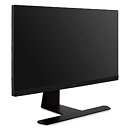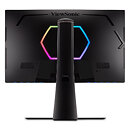Thursday, October 8th 2020

ViewSonic Introduces the XG270Q, the Latest 27-inch ELITE Gaming Monitor with G-SYNC Technology
ViewSonic Corp., a leading global provider of visual solutions, announced the launch of the newest addition to its award-winning ViewSonic ELITE line of gaming monitors with the XG270Q Designed to deliver an amazing gaming experience, the XG270Q features a 165Hz refresh rate, 1 ms (GtG) response time and NVIDIA's G-SYNC Compatible technology for a smooth and seamless gaming experience.
As part of its ELITE gaming portfolio, the ViewSonic XG270Q is a 27-inch monitor that can achieve true 1ms (GtG) response time. Along with the 165Hz* refresh rate and G-SYNC Compatible technology, the XG270Q ensures effortless gameplay within even the fastest scenarios. This gaming monitor also boasts a frameless IPS panel with native QHD (2560x1440) resolution and VESA DisplayHDR 400 certification that brings games to life with vibrant colors and incisive details."ViewSonic developed the ELITE XG270Q, as an option for those looking for a 27-inch screen that offers all the technology features that are important for gamers at a more affordable price range," said Jason Maryne, Product Marketing Manager for ViewSonic ELITE gaming monitors. "We brought in a monitor that can deliver the speed and vibrancy that gamers want, with design enhancements that fulfill the ambiance of a gaming environment. The XG270Q ensures greater visual fluidity and smooth, uninterrupted gameplay."
ELITE XG270Q Gaming Monitor
As part of its ELITE gaming portfolio, the ViewSonic XG270Q is a 27-inch monitor that can achieve true 1ms (GtG) response time. Along with the 165Hz* refresh rate and G-SYNC Compatible technology, the XG270Q ensures effortless gameplay within even the fastest scenarios. This gaming monitor also boasts a frameless IPS panel with native QHD (2560x1440) resolution and VESA DisplayHDR 400 certification that brings games to life with vibrant colors and incisive details."ViewSonic developed the ELITE XG270Q, as an option for those looking for a 27-inch screen that offers all the technology features that are important for gamers at a more affordable price range," said Jason Maryne, Product Marketing Manager for ViewSonic ELITE gaming monitors. "We brought in a monitor that can deliver the speed and vibrancy that gamers want, with design enhancements that fulfill the ambiance of a gaming environment. The XG270Q ensures greater visual fluidity and smooth, uninterrupted gameplay."
ELITE XG270Q Gaming Monitor
- 27-inch gaming monitor with native 2560x1440 (QHD) resolution and a brightness of 400 nits
- IPS panel certified for VESA DisplayHDR 400
- 165Hz refresh rate and 1ms (GtG) response time
- 165Hz refresh rate with DisplayPort
- NVIDIA G-SYNC Compatible technology to eliminate screen-tearing and minimizing stutter and input lag
- It features a frameless design and built-in speakers, along with an integrated mouse anchor, headphone hook, ELITE RGB ambient lighting and ultra-thin brushed aluminium base
- Available in mid-October 2020 for an estimated street price of $479.99





13 Comments on ViewSonic Introduces the XG270Q, the Latest 27-inch ELITE Gaming Monitor with G-SYNC Technology
displayhdr.org/
edit: However, since you mentioned surface area, it's probably not quite the same experience since all the lumens from a bulb are concentrated in a very small space whereas it's spread over the whole screen with a monitor. Still, it's too bright with the possible exception of an office environment (generally better lit than an average room in a home). This is just my opinion I reckon... My current non-HDR monitor (250 nits rated) is too bright except in the daytime with sun coming in.
I think it's time to get some decent HDR panels to the market without being crazy expensive.
IS coming out soon and according to spec supports HDR 600 but the price is listed at $1099.99. so not cheap for a 1440 panel.
Peak luminance of 600 cd/m2
You won't have 600 cd/m2 on a dark scene. Say you have a bright sky you might end up with elements of the scene that should reach 600 cd/m2. So HDR600 doesn't mean your display will always output at 600 cd/m2, comparison to a lightbulb is invalid here.
True HDR effect is about showing your lowest luminance together with the peak without screwing up anything in between.